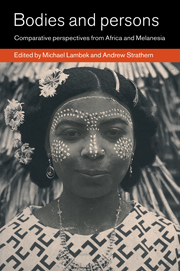Book contents
- Frontmatter
- Contents
- List of illustrations
- List of contributors
- Acknowledgments
- 1 Introduction: Embodying sociality: Africanist–Melanesianist comparisons
- Part I Transcending dichotomies
- Part II Transitions, containments, decontainments
- 6 Treating the affect by remodelling the body in a Yaka healing cult
- 7 To eat for another: taboo and the elicitation of bodily form among the Kamea of Papua New Guinea
- 8 Electric vampires: Haya rumors of the commodified body
- Part III From exchange to history
- Bibliography
- Index
8 - Electric vampires: Haya rumors of the commodified body
Published online by Cambridge University Press: 05 June 2012
- Frontmatter
- Contents
- List of illustrations
- List of contributors
- Acknowledgments
- 1 Introduction: Embodying sociality: Africanist–Melanesianist comparisons
- Part I Transcending dichotomies
- Part II Transitions, containments, decontainments
- 6 Treating the affect by remodelling the body in a Yaka healing cult
- 7 To eat for another: taboo and the elicitation of bodily form among the Kamea of Papua New Guinea
- 8 Electric vampires: Haya rumors of the commodified body
- Part III From exchange to history
- Bibliography
- Index
Summary
Introduction
During my field research I occasionally heard reports of “greedy” people who had made their fortunes by stealing and selling other peoples' blood. As my neighbors talked with me about such diverse matters as the number of well-stocked stores in a particular town, or the dangers of life in urban areas they often brought up rumors of blood stealing. In their accounts, the victims of blood extraction and blood selling were not of much interest. I never heard anyone claim that someone they knew, or even knew of, had been murdered by blood sellers. What was of interest was the fact that vast sums of money could be made by such blood sellers, who acquired their victims by a variety of means. As one young Haya man described this phenomenon to me:
You can see a person who has a brick house, a store, cars. And you think a year ago he was the same as me, but he hasn't done any work. How did he get these things? You know he has been selling people's blood.
Wealth in itself, in such accounts, is not a sign of wrong doing, but the perception of a sudden and inexplicable shift in fortunes can invite suspicion.
Cars, in particular, were cited in Haya rumors as objects typically acquired through such nefarious actions. While most rumors spoke of the practices of blood stealing in general terms and without reference to particular cases, the one individual I knew of who was identified as being a blood seller was reported to have purchased his Land Rover with money made from his victims' blood.
- Type
- Chapter
- Information
- Bodies and PersonsComparative Perspectives from Africa and Melanesia, pp. 172 - 194Publisher: Cambridge University PressPrint publication year: 1998
- 16
- Cited by



